
|
Back to |
| The Front Page |
| The Game |
|
Origins of croquet reconsidered |
|
by David Drazin illustrations provided by David Drazin Posted August 29, 2009
|
With all due respect to Charles Darwin in the year of his two-hundredth birthday, our resident historian reconsiders the origins and evolution of our favorite game, replete with missing links, false starts, sudden leaps forward, and abrupt extinctions. The no-doubt rude beginnings of our refined game, like the violent origins of our species, are still shrouded in mystery, once you try to trace the game back before the middle of the nineteenth century. You won't find many exposed roots. But it's fun to look for them, and even more fun to speculate about what probably happened, and how it must have come about.
It makes sense to consider the origins of croquet in Charles Darwin's bicentenary year, because so much hangs on what makes a game. Darwin was much too busy with species to be bothered with games, but he might have given them his attention, because an understanding of their evolution in general is critical to a consideration of the origins of any particular game.
Many of us would dearly like to know exactly when croquet was born, where, and whom we might revere as its progenitors, but as the years go by the quest for the holy grail looks increasingly bleak. In his definitive book on the history of the game, David Prichard concludes that the origins of croquet are shrouded in the mists of time but is certain enough that it existed in Ireland "perhaps as early as the 1830s.". Although there is evidence to support this meagre fact, it is remarkable that in the years since Prichard wrote in 1981 there has still been no sighting of a pre-1860 Irish document that refers to the game.
A lot of perhaps and maybe
But what is a game? When is a game a GAME? Maybe someone spoke of something happening elsewhere, or maybe somewhere in Ireland some folk tried striking a ball when in contact with another and made a game of it by adding a few rudimentary rules. And maybe those folk got together another day and/or with folk from another place, and made a few more rules to cater for freakish situations that had arisen. And maybe this game was taken up by other groups, who then engaged in inter-group rivalry. Maybe someone coined a cute name for all this. And maybe other folk elsewhere, unbeknown to the first lot, struck one ball against another, and didn't take it further. Maybe they were gated by governesses!
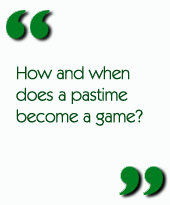
So what do we hold to define a game; and how should it be played, by whom, and for how long, to merit the designation 'game'? And when does one game lose its identity and become another? For the artifacts from which outdoor games are fashioned - lawns, sticks, balls, nets, pins, hoops, and other targets - are ubiquitous and can reasonably be assumed to date back to the year dot.
We'd like to have consensus on all these fundamental questions, and historians give us something not far short of consensus. But I suspect that their authority is a function of recency, especially the strength of recent memory. So they are generally agreed about happenings as far back as the nineteenth century, but rather hazier about the early history of pall mall, lawn billiards, beugelen, and other games from which croquet may have evolved.
Equipment, grounds, and mode of play are obviously important variables, possibly contributing to a game's identity and name. Major Wingfield gave the name Sphairistikè to his invention, but very soon it became known as lawn tennis because it shared so many characteristics with jeu de paume, a long-established game played in a closed court, known in English-speaking countries as "real tennis" and later as simply tennis as so many other surfaces besides grass came into play.
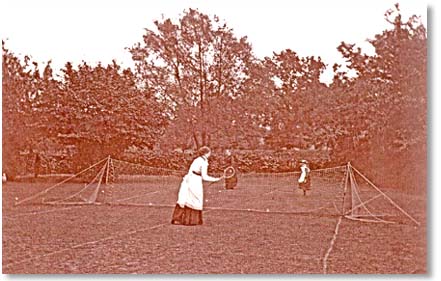
|
| The only known photograph of Major Wingfield's hour-glass lawn tennis court, with both his high main net and mysterious side-nets. Front cover of Brandt Rowles, Gerald Gurney, and Christopher Elks, Early Lawn Tennis in Great Britain as shown by Photographic Images (2006). |
But intent and continuity may be even more critical. By continuity I mean the continuous interaction of groups of players, within and/or between clubs, cemented perhaps by umbrella organisations (like the English Croquet Association). One can draw a continuous line of intent and interaction from mid-nineteenth century Ireland to the national associations of the "big four" MacRobertson Shield countries today, so croquet remains croquet despite massive development.
When a croquet stroke is something else entirely
Nevertheless, that line of development was deliberately severed in 1882 by some breakaway clubs, notably the National American Croquet Association, leading to roque, roque clubs, and the American Roque League, notwithstanding many characteristics in common with croquet. The significant point is that the word "croquet" was carefully removed from their rule book and discourse. The stroke with two balls in contact for which croquet is named was gone from roque. Instead, roque players "counted on" or "played off" another ball. Thenceforth they wanted the world to know that they were playing a more scientific game, with its own distinct identity. That position was upheld at the St. Louis Olympics in 1904: whereas they might have played croquet as they did in Paris in 1900, in St. Louis they called it roque.
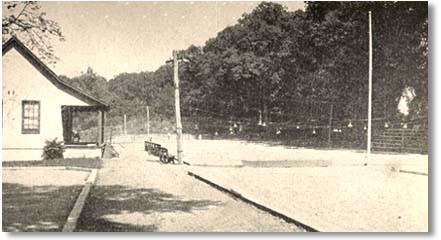
|
| Courts of the National Roque Association, Norwich, CT. Plate in Lawn Sports, published by American Sports Publishing Company (1915). |
Prospects for roque looked very bright for a while. Many public courts were built by the US government in the 1930s version of "economic stimulus" in the Great Depression. By the twenty-first century, most had fallen into disuse and the game of roque became a dead end on croquet's evolutionary tree.
Is gateball croquet? Is a chimpanzee a person?
This raises interesting questions about golf croquet and gateball. Theoretically the line of continuity might yet be broken if golf croquet came to be played by independent clubs under the control of breakaway associations. The game might then be called something different, and the term "croquet" could conceivably be dropped. That it acquired the name "croquet-golf" in the first place may be due to the fact that it was launched in 1896 by F.H. Ayres, the inventor, as a fun game for play with croquet equipment by croquet players. That it will more probably continue as a version of croquet (rather than an independent breakaway) may be chiefly due to the more recent prominence of Egyptian players. For the Egyptian Croquet Association, now a leading member of the World Croquet Federation, croquet was always golf croquet.
Though gateball, played predominantly in the Far East, may share more features in common with croquet than does golf croquet, gateball may never be seen as a version of croquet, simply because there is no line of intent or continuity such as can be traced for golf croquet, beginning with its English roots and continuing with its ultimate refinement by the Egyptians after they threw the French and English out of their country in the 1950s to nationalize the Suez Canal. Gateball, by contrast, seems to have sprung up, full-blown, virtually overnight in Asia in the twentieth century, independent of any kind of relationship to croquet associations.
What Miss Macnaughten saw
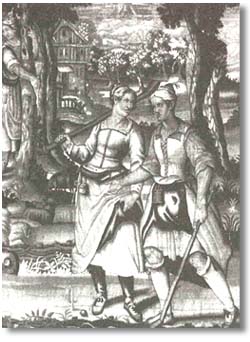
|
| A ball game redolent of croquet in a sixteenth-century French tapestry. Courtesy: Collection Fenaille. In Christopher R. Reaske, Croquet: The Gentle but Wicket Game (1988). |
Writing in 1991, Hooper also mentions the French refugees who settled in the neighbourhood of Portarlington, not far from Dublin, in the seventeenth and eighteenth centuries. Could they have brought croquet with them? Possibly, but again we have no proof.
The simple fact is that there is no hard evidence of croquet having been played anywhere in continental Europe during the early decades of the nineteenth century. There could of course be extant reports of croquet being played in Ireland around this time. The British Library Newspaper Library in Colindale, outer London, is claimed to hold the largest collection of Irish newspapers in the world, and there they are, waiting to be examined. But personal experience with microfiche technology has shown this to be a desperately boring activity. I have encouraged local historians to delve into the relevant county newspapers in local libraries, but so far without outcome, positive or negative.
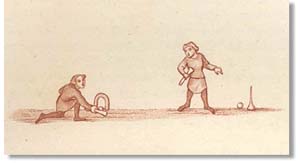
|
| 'A very curious ancient pastime'. From a plate in Joseph Strutt, Glig Gamena Angel Deod; Or, The Sports and Pastimes of the People of England(1801). |
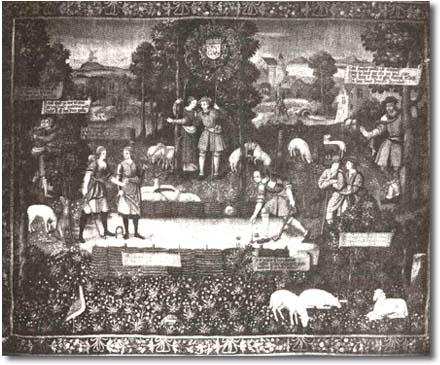
|
| Another croquet-like ball game in a seventeenth-century Flemish tapestry. From Kozel Castle, Czechoslovakia. In Christopher R. Reaske, Croquet: The Gentle but Wicket Game (1988). |
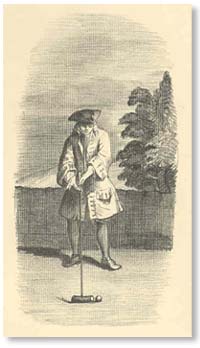
|
| A pall-mall player aiming and preparing to strike his ball. Frontispiece of R.C.A. Prior, Notes on Croquet (1872), after Lauthier (1717). |
My pet fantasy is that it began somewhere in Ireland early in the nineteenth century, when someone discovered that it was fun to "send" a roqueted ball by putting a foot on the striker's ball in contact with the other ball ("tight" croquet). Rules evolved, and someone, idling away a rainy day in the library of a stately home, happened upon the word "croquet," meaning a stick, the sort of thing you hit a ball with, in a dusty old dictionary, du Cange's Glossarium ad Scriptores mediæ et infimæ Latinitatis. A circumflex accent was added, the game and name caught on, and vitally a line of continuity to the present day was established. All this is consistent with the known facts. The only thing lacking is proof: we don't know who did what, where, and when.
Some species of games went extinct without a trace
Just a word or two about so many games originating in the early decades of the nineteenth century. Darwin step forward! There could have been many more proto-games first played at this time that we don't now remember because they never got going (or moved promptly to extinction). So the ones that persisted to today are only a fraction of the number that started life. A serious historian might cite many causative factors: the start of mass transportation with the railways, allowing intergroup competition; the invention of the lawnmower, facilitating the preparation of fine turf; the birth of the machine press, permitting the inexpensive production of rulebooks.
And I suspect the equal influence of fundamental socio-economic developments, like the incipient emancipation of women and the rise of the middle class. Would croquet ever have caught on in the 1850's if not for its cachet as a coed sport? If local governmental jurisdictions had not built countless greens for lawn bowling and croquet everywhere from Sydney to Manchester in the great age of public parks a hundred years ago, would croquet have survived to the present day as a middle-class pastime?
And what of the future? What effect will exploding populations and increasingly scarce real estate for playing fields have on the future evolution of sport? Already there are signs that golf has eaten up more than its share of the landscape, and gateball's rapid rise may be in some way related to its space efficiency as compared to golf, or even to croquet.
Whatever it's course, croquet's future in an age of mass communications will be more easily traceable than its murky past, and its continued evolution will be shaped in tandem with the evolution of human beings in the increasingly complex and unpredictable world we will create.